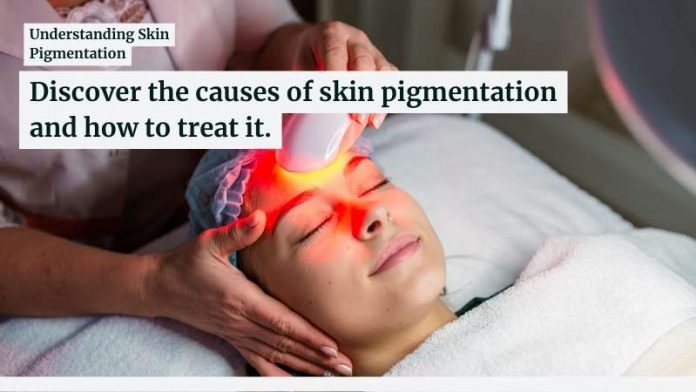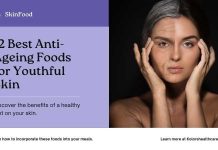You might have noticed small dark patches or areas with discolouration on your face when looking closer at the mirror. Though freckles can be a cute addition, these dark grey or brown patches are bigger, have uneven skin colour, and will be persistent on your face and neck. Facial pigmentation characterized by brownish spots is usually caused by your skin’s archrival, the sun. Exposure to the sun’s UVA rays consistently can damage your skin and lead to pigmentation. This skin issue affects your skin’s look and might indicate an underlying health issue.
Understanding the reason behind the pigmentation on your face will help identify the right solution to optimize your skin health and boost confidence. Read on to learn about the causes of pigmentation on the face, how environmental and genetic factors influence it, how to prevent and protect it, and about professional treatments [1].
What Is Facial Pigmentation?
Pigmentation on your face can occur as tiny dark patches around your lips, below the eyes, across the neck, or on the forehead. It is a regular skin issue that makes the skin look darker and might appear in clusters [2]. When your skin produces excess melanin, it causes facial pigmentation. Sun exposure and genetics can worsen its appearance and lead to blotchy and dark patches, which can be unsightly [3].
Types of Facial Pigmentation
Pigmentation is a common concern, and most of you might have suffered at any point in time from any of the following types of facial pigmentation [4].
1. Freckles – A Type of Pigmentation Caused by UV Exposure
This type of hyperpigmentation is triggered by excess melanin production in the skin. It occurs on the face when the skin is constantly exposed to sunlight. Genetics are vital in influencing how many freckles your skin might develop as you age. If your skin is prone to sun damage, it will release more melanin to protect the skin. It causes DNA damage inside the melanocyte, which causes the development of ephelides, which is also known as freckling pigmentation.
2. Melasma: A Type of Pigmentation Caused by Hormones
Fluctuations in hormones cause this type of pigmentation. About 30% of women possess a genetic disposition that makes their skin produce excess hormones that are responsible for producing melanin pigment when taking hormonal contraception pills, undertaking HRT or hormone replacement therapy, or when pregnant. This type of pigmentation has a symmetrical appearance with not-so-defined borders. Sometimes, the pituitary gland releases too much melanin-inducing hormone, which can cause melasma.
3. PIH or Post-Inflammatory Hyperpigmentation
Post-inflammatory hyperpigmentation, or PIH, is caused by excess melanin production or the deposition of a high amount of melanin in the dermis or epidermis layer. An injury, trauma, or inflammation might cause it. Any injury, trauma, or inflammation in the epidermis layer kindles the melanocytes to raise melanin synthesis and aids in pigment transfer around the keratinocytes. PHIP is usually found in darker skin tones based on the Fitzpatrick scale, and the pigmentation is brown due to the presence of melanin.
4. Solar Lentigo
You commonly called age or liver spots, a dark, harmless patch on your facial skin that characterizes solar lentigo. It is caused by too much exposure to the sun’s UV rays, which triggers melanocytes to increase and accumulate melanin inside the keratinocyte cells. These age spots slowly develop as you cross 40 years of age and can be identified by their well-defined, flat patches in oval, round, or irregular shapes in shades of black, brown, or tan.
5. PIE or Post-Inflammatory Erythema
Post-inflammatory erythema can be easily identified by its purplish, pinkish, or reddish patches on the facial skin where the acne inflammation would have halted the blood flow. This type of facial pigmentation is commonly found in people with acne-prone skin and among lighter skin tones based on the Fitzpatrick scale [5].
Common Causes of Pigmentation
To identify the type of facial pigmentation you have, it is essential to identify the potential triggering factor behind the skin issue. Some of the causes of pigmentation are:
1. Prolonged Exposure to Sun
Exposing your skin to harsh sunlight for a long time can have damaging effects on your skin health. To combat the effects of prolonged exposure to sunlight, your skin produces excess melanin by stimulating melanocytes to cause pigmentation on the face in patches or sun spots.
2. Change in Hormones
A major cause of facial pigmentation is fluctuations in specific hormones in your body during puberty or pregnancy. Activities like consuming contraceptive pills might also cause hormonal changes, which can wreck the skin and lead to melanin production. Such disruption in hormonal balance will lead to hyperpigmentation like melasma, which features greyish and brown patches on the skin.
3. Ageing
As you age, your body loses its ability to produce melanin pigment as the number of melanocytes reduces. Prolonged sun exposure may cause the development of dark spots or brown spots as the skin loses its ability to fight UV ray damage. As your skin looks paler and thinner with age, pigmentation or dark spots will surface on your face or neck when exposed to direct sunlight. These pigmented patches or spots on your facial skin are called solar lentigos.
4. Symptoms of an Underlying Medical Condition
Facial pigmentation might be a symptom of an underlying medical condition like Addison’s disease or hemochromatosis. The pigmentation caused by these medical conditions will not only occur on the face or neck but also spread to your elbows, knees, and toes.
5. Unhealthy Diet
Your erratic food habits can also cause pigmentation on your face. Sugary foods have a high glycemic index, which can be a major cause of hyperpigmentation. And sugar deconstructs collagen, which is responsible for improving your skin’s elasticity to make it look young and supple. Consuming foods loaded with spice and fats or drinking caffeinated drinks will also cause hyperpigmentation.
6. Role of Drugs
Sometimes, specific drugs and medications like NSAIDs, non-steroidal anti-inflammatory drugs, hormone replacement treatment drugs, anti-seizure medications, and antibiotics can cause hyperpigmentation on the face. These drugs might cause a side effect or reaction by causing discolouration or pigmentation on the skin in the form of dark patches.
7. Too Much Use of Skin Products with Harsh Chemicals
Cosmetics or skin care products might contain toxic chemicals, which can affect the natural melanin makeup of your skin. Skincare products like hair removal creams and waxing strips might cause facial pigmentation like post-inflammatory hyperpigmentation, or PIH.
8. Acne Breakouts
Acne breakouts are one of the most common culprits causing facial pigmentation. After your acne dries, it may leave a few marks or dark spots on your skin, which might cause post-inflammatory hyperpigmentation or PIH. To defend against such infections, your skin will release excess melanin, which can cause dark-pigmented patches.
Role of Genetic and Environmental Factors in Pigmentation on Face
Studies reveal that over 100 genes have a pivotal role in processes like melanocyte distribution, identifying synthesized melanin types like pheomelanin [6] and eumelanin, sending melanosomes to reach keratinocytes, and migration of melanoblast [7]. Several genes are responsible for the polygenic trait of skin pigmentation, while others help influence the height and traits of an individual. You will get facial pigmentation if any of your parents already have it.
Melanin possesses phytochemicals that help shield your skin from the harmful effects of UV radiation. Too much exposure to UV rays will cause damage to the salts, proteins, and nucleic acids, which can harm skin health. For people with lighter skin tones, vitamin D3 synthesis is higher than for those with darker skin tones. So, the major role of melanin is to enhance your skin’s photoprotection and lower the risk of photocarcinogenesis and photoaging. Environmental factors like exposure to sunlight and UV radiation will harm your skin and cause pigmentation on the face.
Prevention and Protection for Pigmentation On Face
You can protect or prevent your face and skin from pigmentation by following the tips mentioned below:
1. Don’t Forget Sunscreen
Sunscreen will help prevent dark spots, sun spots, or pigmentation caused by sun rays by shielding against damaging UV rays. Lowering UV exposure will help cut down on too much melanin production. Use a sunscreen with zinc or titanium oxide that has a water-resisting formulation with at least SPF 30 to give you broad-spectrum protection [8].
2. Limit Sun Exposure
Even though it is not possible to spend every day indoors when the sun is out, limiting your sun exposure hours will be helpful to prevent pigmentation on your face. You can also use an umbrella, a scarf, or a hat to protect yourself from harsh sun rays.
3. Include Vitamin C
Include a Vitamin C serum in your regular skincare regime to correct the discolouration and skin pigmentation. It brightens skin and keeps it hydrated to prevent dark patches.
4. Use OTC Products
Any OTC products you pick for a pigmentation-free face should contain effective ingredients like retinoids, kojic acid, glycolic acid, and azelaic acid.
5. Don’t Pick Your Face
You might be tempted to pick the skin if you have acne-prone skin. However, avoid picking up acne, which can cause inflammation and hyperpigmentation. However, consult your dermatologist if you have dermatillomania [9], which is a clinical skin picking issue, to avoid hurting your facial skin.
6. Hydrate and Exfoliate
Always ensure that moisturization and exfoliation are a part of your skincare routine to protect against facial pigmentation. Hydrated and exfoliated skin will help achieve healthy skin free from issues like hyperpigmentation.
7. Choose Skin-friendly Ingredients
Using face creams and lotions with effective ingredients like kojic acid, liquorice, and vitamin C will aid in lowering pigmentation on the face through tyrosinase inhibition [10], which is responsible for producing melanin pigments.
Overview of Treatments Available at Kolors Healthcare
Medical intervention and prevention at an early age are essential to prevent pigmentation on the face from spreading further. If you face facial pigmentation, fix an appointment with the skin experts at Kolors Healthcare to learn about their effective treatments. You can choose from any of the following treatment options performed by professionals to give you a glowing and flawless face:
1. Dark Spot Treatment
This skin-brightening treatment from Kolors Healthcare is an apt choice for people with a fair skin tone and sensitive skin. This treatment lightens your pigmentation patches to give you an even skin tone. You will not experience any side effects or irritation after this treatment. With this dark spot treatment, you will have healthy and brighter facial skin that is well-hydrated, has fewer pores, and has a better texture. Book an appointment at Kolors Healthcare today!
2. Skin Whitening Treatment
This skin fairness treatment by Kolors Healthcare is an effective choice to lower the appearance of pigmentation patches caused by acne, sun damage, and freckles. This treatment reveals fresh-looking, rejuvenated skin, gently removing the dead and damaged skin layers. It also corrects the uneven skin tone triggered by ageing and restricts melanin production to achieve naturally radiant skin with a lighter skin tone. Your dermatologist will suggest this treatment for facial pigmentation after identifying the underlying cause to achieve a sustainable transformation.
3. Skin Polishing Treatment / Microdermabrasion
Skin polishing treatment, or microdermabrasion, is performed by removing the top skin layer to remove pigmentation marks and acne scars. This treatment will make your skin smoother, softer and radiant while enhancing the skin tone. The unsightly pigmentation marks are removed through circular strokes that gently polish the skin to effectively remove the dark patches or spots.
4. Chemical Peels
To minimize or erase the pigmentation on your face, your doctor might suggest chemical peels offered by Kolors Healthcare. The topmost layer of your skin will be removed naturally after applying a chemical serum with hydrating properties. This fractional resurfacing treatment focuses on deep exfoliation of the upper layer of the skin to reveal fresh and radiant skin that is healthy and free from pigmentation. Chemical peels contain potent chemical solutions that treat a wide range of skin issues like acne scars, wrinkles, uneven pigmentation, fine lines, brown spots, and more. Based on the severity of your facial pigmentation, the dermatologist at Kolors Healthcare will recommend chemical peels with light, medium or high strength to derive the desired results.
References
- Stephen A. Ainger, Kasturee Jagirdar, Katie J. Lee, H. Peter Soyer, Richard A. Sturm – https://karger.com
- L’Oréal Research and Innovation, 1 avenue Eugène Schueller, 93601 Aulnay-sous-Bois, France – https://www.mdpi.com/1422-0067/19/9/2668
- Faculty of Pharmacy, Nursing and Health Professions, Birzeit University, Ramallah 00972, Palestine – https://www.ncbi.nlm.nih.gov/pmc/articles/PMC10304091/
- SCOTT PLENSDORF, MD, MARIA LIVIERATOS, MD, AND NABIL DADA, MD – https://www.aafp.org/pubs/afp/issues/2017/1215/p797.html
- American Academy of Family Physicians – https://www.aafp.org/content/dam/brand/aafp/pubs/afp/issues/2017/1215/p797-t2.gif
- Alessandra Napolitano, Lucia Panzella, Giuseppe Monfrecola, Marco d’Ischia – https://onlinelibrary.wiley.com/doi/10.1111/pcmr.12262
- Paulina Borówka, University of Lodz – https://www.researchgate.net
- American Academy of Dermatology Association – https://www.aad.org/
- Internal Medicine, Temple University Hospital, Philadelphia, USA – https://www.ncbi.nlm.nih.gov/pmc/articles/PMC7910222/
- – https://www.ncbi.nlm.nih.gov/pmc/articles/PMC6010116/









